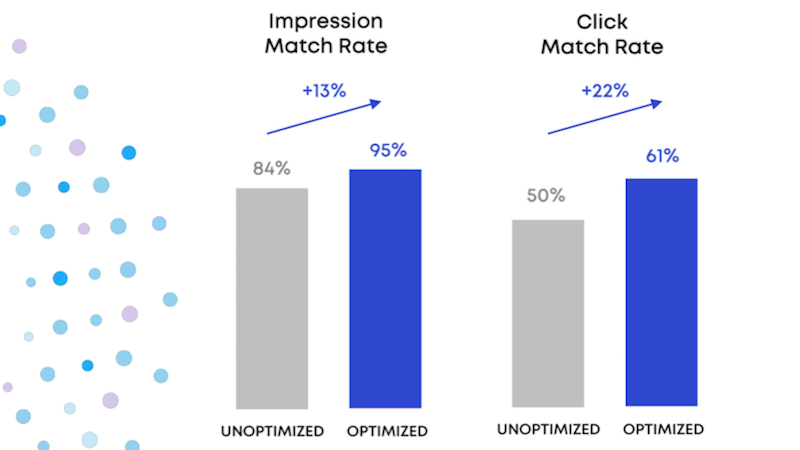Lucidity’s new report shows a successful field test for blockchain-based ad optimization
The results indicate high levels of fraud and waste in the system, but large lifts for campaigns that optimize for authenticated inventory and providers.

Impression and click match rates for mid-campaign optimization away from “discrepant” sources, per the Lucidity report.
Blockchain and reality joined forces this week, as startup Lucidity offered some of the first stats backing the dreams that blockchain can make digital advertising more transparent and less wasteful.
The Marina Del Rey, Calif.-based firm has released a report, “Ad Transparency Report 2019” (free, registration required), about a pilot program where its blockchain-based platform tracked programmatic media buys by a dozen advertisers in Q3 and Q4, as part of the Interactive Advertising Bureau Tech Lab’s blockchain field test.
‘Most complete record.’ Lucidity described the report as “the most complete record of results from a blockchain-powered digital advertising solution to-date.” The results, the company said, validate that there is a high level of waste and fraud in the programmatic ad system, and help prove that blockchain can help solve these problems.
The report noted that each member of the ad supply chain currently only has a partial view of ad-related data, such as a demand-side platform (DSP) that is only connected with the ad agency running the campaign and an ad exchange. Additionally, there are different methods for measuring results throughout the supply chain.
“If a DSP didn’t see a metric that, say, the advertiser’s ad tracker did,” COO Nikao Yang said via email, “that creates a discrepancy.” He added that discrepancies indicate “waste and fraud,” and create doubt about the validity of the measurements.
But, he noted, his company’s blockchain system tracks data from the relevant parties involved in a campaign, authenticating — or failing to authenticate — every impression and click.
With this data, Lucidity matches signals between the ad trackers, demand-side platforms and exchanges, through the blockchain-based shared ledger. The results point to major improvements in campaign efficiency, reporting and conversions.
65 percent match rate for in-app impressions. The report noted that, when the ledger confirms all relevant members of the supply chain have verified a particular piece of data, such as an impression, then that data point is confirmed as authentic through a blockchain-generated smart contract. If it hasn’t been verified by all relevant parties, that data point is considered a “discrepancy.”
Out of nearly 30 million impressions on desktop, mobile web and in apps that were tracked, only 86 percent could be confirmed from all parties, yielding what the report described as an 86 percent match rate. Impressions in desktop and mobile web had a very healthy 96 percent match rate, but, for in-app impressions, it was an “abysmal” 65 percent.
The report described possible causes of discrepancies: ad fraud due to bots, various standards for measurements or “auction games,” such as bid caching, where an unsuccessful bid is held for a later inventory availability. In any case, the report said discrepancies indicate “fraud and wasted spend.”
More astonishing, it could only confirm 52 percent of all the clicks in the tracked campaigns — about 33,000 out of about 64,000, on desktop, mobile and in apps.
This stat is consistent with the recent observation by the CEO of mobile measurement firm Adjust, which has just released a new standard to counter mobile click fraud. He estimated that somewhere between a third and a half of all mobile web and in-app ad clicks are fraudulent.
That’s not the only bad news for mobile advertisers. The Lucidity pilot could only confirm about two-thirds of all in-app inventory. In other words, a third of the in-app inventory in this pilot consisted of what the report called “questionable inventory.”
Why you should care. “So much of advertisers’ frustrations today,” Yang said, “is because a lot of the data they’re basing decisions off of just isn’t accurate [and that] leads to bad outcomes.”
While the Lucidity platform by itself cannot correct the “questionable” inventory, impressions or clicks, it can guide advertisers to ad tech providers and to inventory that is verified by all parties.
The report indicated this kind of optimization could lead to a major bottom-line boost. When discrepant impressions and clicks were removed from one unnamed campaign, for instance, the report said, “conversion rates increased by over 214 percent.”
In a test with an unnamed major entertainment studio for a global film release, the campaign — on desktop, mobile web and in apps — was split into a first “unoptimized” phase, run normally, and a second, “optimized” phase, which eliminated inventory showing a high level of discrepancy. Both phases delivered around ten million impressions.
The first unoptimized phase had 300 percent the number of clicks but only one-third the number of conversions resulting from click-throughs, compared to the second, optimized phase. The report said this indicated the “elimination of discrepant inventory also eliminated a lot of fraudulent (i.e. bots) that artificially inflate numbers.”
Lucidity also reported that, in a campaign with Toyota, there was an overall performance lift of 21 percent by optimizing with blockchain-confirmed metrics.
If these stats and others in the report prove to be valid for the broader ad ecosystem, blockchain-based verification could deliver the kind of major cleanup to the advertising industry that its proponents have championed.
Contributing authors are invited to create content for MarTech and are chosen for their expertise and contribution to the search community. Our contributors work under the oversight of the editorial staff and contributions are checked for quality and relevance to our readers. MarTech is owned by Semrush. Contributor was not asked to make any direct or indirect mentions of Semrush. The opinions they express are their own.
Related stories
